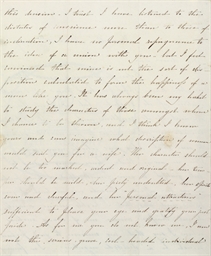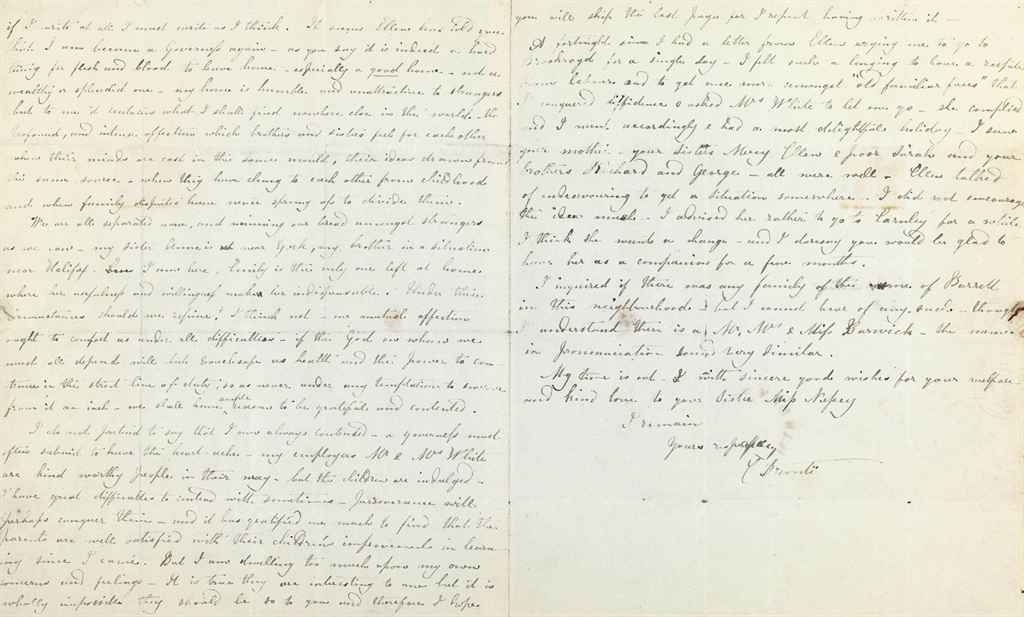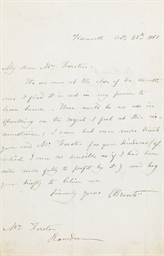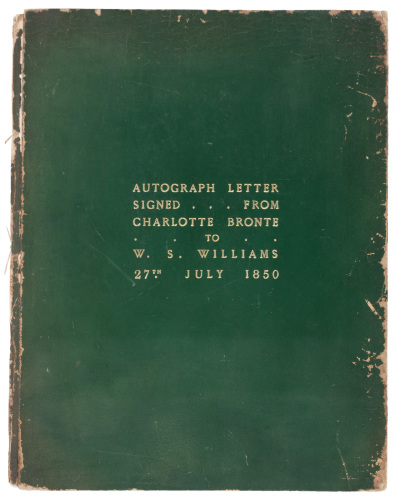BRONTË, Charlotte (1816-1855). Autograph letter signed ('C. Bronte') to W[illiam] S[mith] Williams, [Haworth], 9 November 1849, on mourning paper, 3 pages, 8vo , integral blank (the letter tipped onto folio album leaf, the envelope pasted on below with back folded out, lacks postage stamp). Provenance : Pencarrow Collection of Autograph Manuscripts, Sotheby's London, 8 December 1999, lot 4.
BRONTË, Charlotte (1816-1855). Autograph letter signed ('C. Bronte') to W[illiam] S[mith] Williams, [Haworth], 9 November 1849, on mourning paper, 3 pages, 8vo , integral blank (the letter tipped onto folio album leaf, the envelope pasted on below with back folded out, lacks postage stamp). Provenance : Pencarrow Collection of Autograph Manuscripts, Sotheby's London, 8 December 1999, lot 4. A CRITIQUE OF A WOMAN WRITER AND REACTION TO HER OWN CRITICS. Charlotte Brontë acknowledges receipt of a parcel of newspapers and books, going on to criticise in particular Lady Morgan's Woman and Her Master : while she has 'as yet perused but little of it', she tells Williams 'how I am impressed. Candidly -- not favourably. Not content with elevating "women", she seeks to disgrace "Man" -- this is not fair. Moreover her style is very pompous ... one feels that she often writes rather from a pedantic wish to show her learning than from an earnest desire to impress others with truths of which she is herself sincerely convinced.' As for the newspapers, while allowing that the critics writing for the Spectator and Athenaeum (about the recently published Shirley ) are 'acute men in their way', she feels that 'when called on to criticise works of imagination -- they stand in the position of deaf men required to listen to music -- or blind men to judge of painting. The Practical their minds can grasp -- of the Ideal they know nothing.' The letter ends with a confession of her inability to 'emulate your Cornhill neatness' in wrapping books: 'the brown paper and the hard cord will not be tractable -- and I fear the unseemly bundles I produce must shock you much.' Charlotte had first met William Smith Williams when the Brontë sisters made their unannounced visit to Smith, Elder in July, 1848. As reader and literary adviser to the firm, he alone had spotted promise in the manuscript of The Professor , and despite her fierce independence she continued to value his opinion highly. The deaths of Branwell and Emily before the end of 1848, and of Anne the following May, had left her 'stripped and bereaved'. Yet she had persevered as Currer Bell and followed Jane Eyre with Shirley , published by Smith, Elder on 26 October 1849. Her previous letter to Williams (5 November) had been to thank him for the parcel of copies he had sent her. The present letter of 9 November was written after the disappointment of reading the first reviews in the Spectator and Athenaeum , copies of which were in the second parcel. Criticism of Lady Morgan's Woman and Her Master (2 vols., 1840) for the pedantry calculated to please male readers gave her the opportunity to reaffirm her own belief in the pursuit of truth and minimise the hurt of being attacked for it in the reviews of 3 November. While finding more of actual life in Shirley than Jane Eyre , the Spectator declared that it contained 'a strong dash of the repelling.' H.F. Chorley's seven-column rant in the Athenaeum announced that it could only have been written by a woman, and detected a harmful tone of 'discontent, disorder and rebellion' in its debate about 'Woman's destiny'. Lady Morgan, née Sydney Owenson (?1793-1859), had made her name as a novelist with The Wild Irish Girl (1806). Recorded in The Letters of Charlotte Brontë , edited by Margaret Smith (3 vols., 1995-2003), II, p. 281, the text only partly quoted in Appendix IV, p. 756.
BRONTË, Charlotte (1816-1855). Autograph letter signed ('C. Bronte') to W[illiam] S[mith] Williams, [Haworth], 9 November 1849, on mourning paper, 3 pages, 8vo , integral blank (the letter tipped onto folio album leaf, the envelope pasted on below with back folded out, lacks postage stamp). Provenance : Pencarrow Collection of Autograph Manuscripts, Sotheby's London, 8 December 1999, lot 4.
BRONTË, Charlotte (1816-1855). Autograph letter signed ('C. Bronte') to W[illiam] S[mith] Williams, [Haworth], 9 November 1849, on mourning paper, 3 pages, 8vo , integral blank (the letter tipped onto folio album leaf, the envelope pasted on below with back folded out, lacks postage stamp). Provenance : Pencarrow Collection of Autograph Manuscripts, Sotheby's London, 8 December 1999, lot 4. A CRITIQUE OF A WOMAN WRITER AND REACTION TO HER OWN CRITICS. Charlotte Brontë acknowledges receipt of a parcel of newspapers and books, going on to criticise in particular Lady Morgan's Woman and Her Master : while she has 'as yet perused but little of it', she tells Williams 'how I am impressed. Candidly -- not favourably. Not content with elevating "women", she seeks to disgrace "Man" -- this is not fair. Moreover her style is very pompous ... one feels that she often writes rather from a pedantic wish to show her learning than from an earnest desire to impress others with truths of which she is herself sincerely convinced.' As for the newspapers, while allowing that the critics writing for the Spectator and Athenaeum (about the recently published Shirley ) are 'acute men in their way', she feels that 'when called on to criticise works of imagination -- they stand in the position of deaf men required to listen to music -- or blind men to judge of painting. The Practical their minds can grasp -- of the Ideal they know nothing.' The letter ends with a confession of her inability to 'emulate your Cornhill neatness' in wrapping books: 'the brown paper and the hard cord will not be tractable -- and I fear the unseemly bundles I produce must shock you much.' Charlotte had first met William Smith Williams when the Brontë sisters made their unannounced visit to Smith, Elder in July, 1848. As reader and literary adviser to the firm, he alone had spotted promise in the manuscript of The Professor , and despite her fierce independence she continued to value his opinion highly. The deaths of Branwell and Emily before the end of 1848, and of Anne the following May, had left her 'stripped and bereaved'. Yet she had persevered as Currer Bell and followed Jane Eyre with Shirley , published by Smith, Elder on 26 October 1849. Her previous letter to Williams (5 November) had been to thank him for the parcel of copies he had sent her. The present letter of 9 November was written after the disappointment of reading the first reviews in the Spectator and Athenaeum , copies of which were in the second parcel. Criticism of Lady Morgan's Woman and Her Master (2 vols., 1840) for the pedantry calculated to please male readers gave her the opportunity to reaffirm her own belief in the pursuit of truth and minimise the hurt of being attacked for it in the reviews of 3 November. While finding more of actual life in Shirley than Jane Eyre , the Spectator declared that it contained 'a strong dash of the repelling.' H.F. Chorley's seven-column rant in the Athenaeum announced that it could only have been written by a woman, and detected a harmful tone of 'discontent, disorder and rebellion' in its debate about 'Woman's destiny'. Lady Morgan, née Sydney Owenson (?1793-1859), had made her name as a novelist with The Wild Irish Girl (1806). Recorded in The Letters of Charlotte Brontë , edited by Margaret Smith (3 vols., 1995-2003), II, p. 281, the text only partly quoted in Appendix IV, p. 756.









.jpg)


Try LotSearch and its premium features for 7 days - without any costs!
Be notified automatically about new items in upcoming auctions.
Create an alert